Mexico's Economic Growth Improves In Second Quarter
from the Dallas Fed
-- this post authored by Jesus Canas and Juliette Coia
Mexico’s gross domestic product (GDP) grew at an annualized 6.1 percent in second-quarter 2021, faster than the first-quarter growth of 3.1 percent. In June, the consensus GDP growth forecast for 2021 (fourth quarter/fourth quarter), compiled by Banco de México, increased from 3.5 percent to 4.0 percent.[ 1]

Mexico still faces headwinds from COVID-19. New cases have increased considerably over the past two months, nearing averages seen at the end of January. Vaccine progress has improved, but only 19 percent of the population has been fully vaccinated.
The latest data available show employment, industrial production, exports, and retail sales grew. The peso/U.S. dollar exchange rate and inflation held steady in June.
Output Growth Accelerates
Mexico’s second-quarter GDP grew above the quarterly average (Chart 1). Output from goods-producing industries (manufacturing, construction, utilities, and mining) increased 1.6 percent, and service-related activities (wholesale and retail trade, transportation, and business services) rose 8.7 percent. Agricultural output grew 2.4 percent.
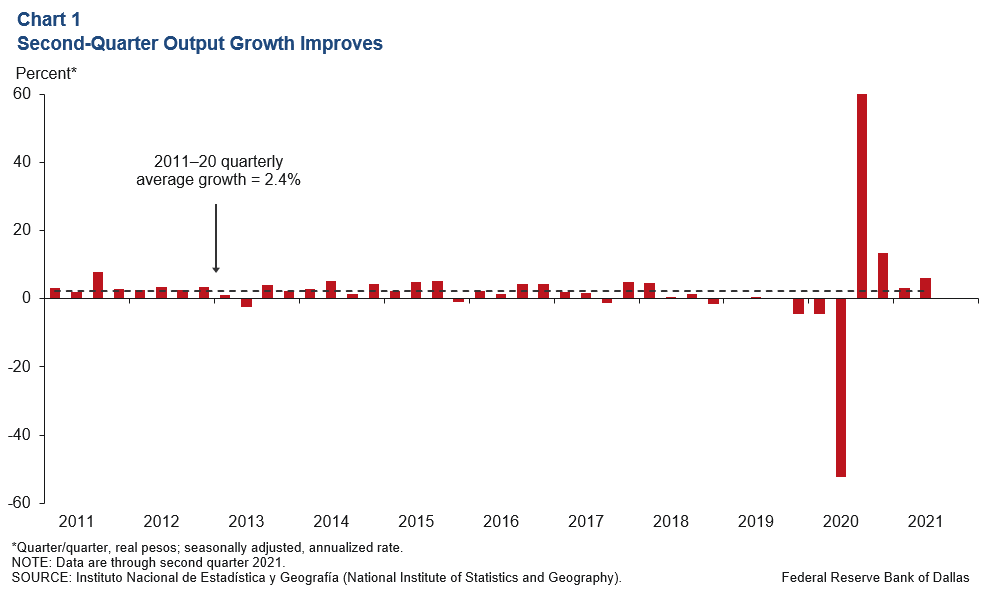
Exports Improve in May
The three-month moving average of total exports rose 1.2 percent in May as oil exports increased 3.6 percent, and the dominant manufacturing category increased 1.2 percent (Chart 2). On a month-over-month basis, total exports ticked up 0.6 percent in May, and manufacturing exports increased 0.1 percent. Mexico’s total exports in May were up 2.9 percent compared with the pre-pandemic levels of February 2020.
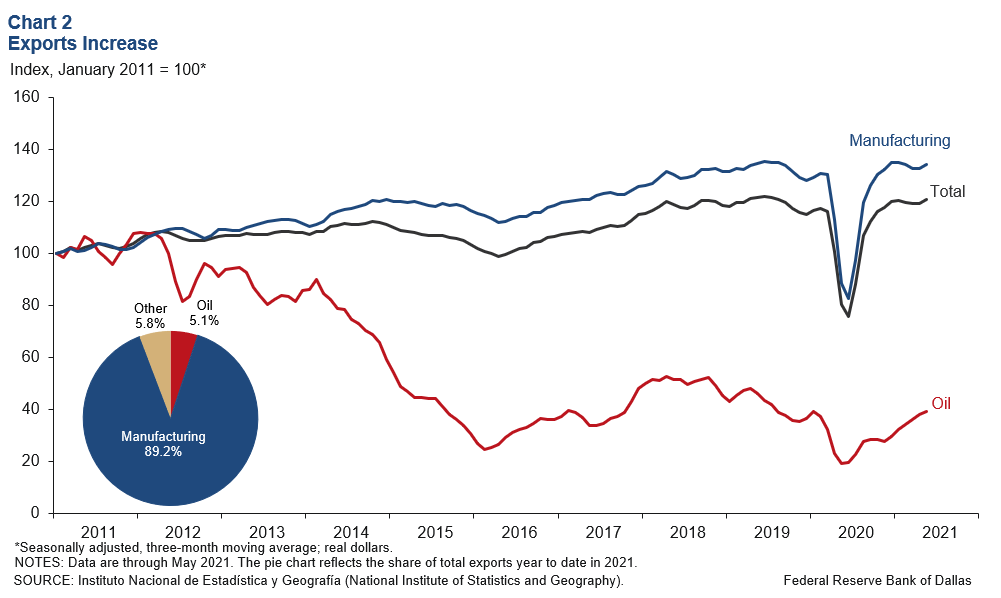
Industrial Production Inches Up
The three-month moving average of Mexico’s industrial production (IP) index - which includes manufacturing, construction, oil and gas extraction, and utilities - increased 0.2 percent in May, and manufacturing IP was up 0.5 percent (Chart 3). On a month-over-month basis, IP was edged up 0.1 percent in May, and the manufacturing index shrank 0.7 percent. North of the border, U.S. IP increased 0.4 percent in June after rising 0.7 percent in May, and the three-month average was up 0.4 percent. The correlation between IP in Mexico and the U.S. increased considerably with the rise of intra-industry trade as a result of the 1994 North American Free Trade Agreement, recently replaced by the United States - Mexico - Canada Agreement.
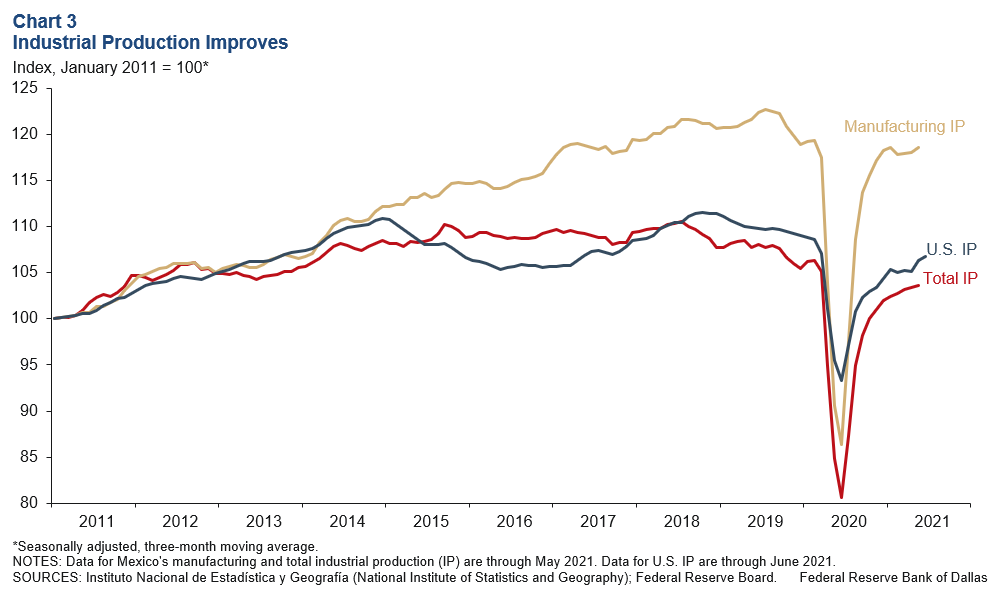
Retail Sales Rise
The index of real retail sales in Mexico increased 1.3 percent based on a three-month moving average through May (Chart 4). On a month-over-month basis, retail sales increased 0.6 percent in May after declining 0.3 percent in April.
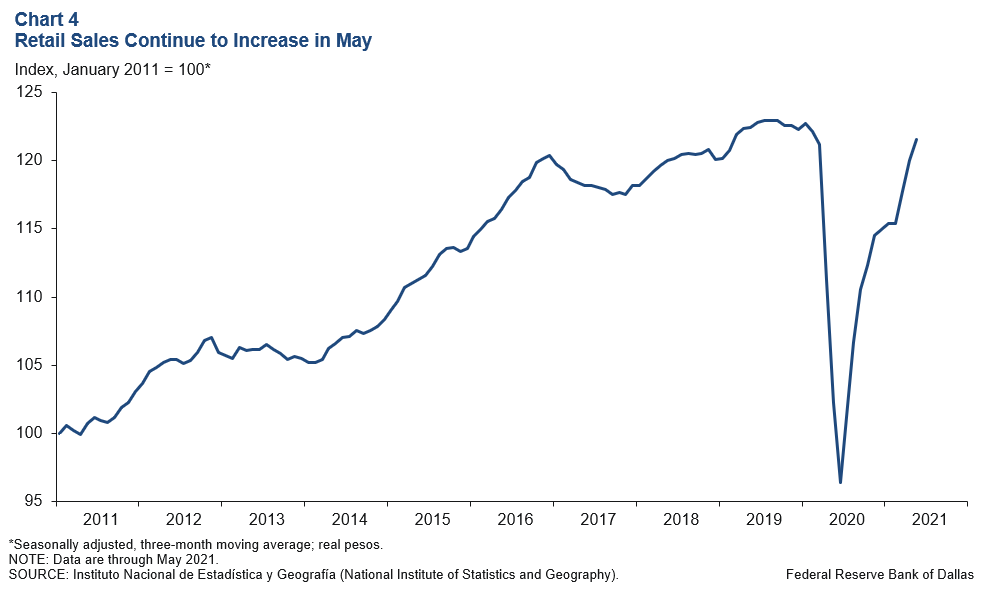
Payroll Growth Solid in June
Formal sector employment - jobs with government benefits and pensions - rose an annualized 8.3 percent (135,00 jobs) in June, similar to May’s 8.4 percent increase (Chart 5). Year-over-year employment grew 3.5 percent in June. Total employment, representing 53 million workers and including informal sector jobs, declined 4.3 percent year over year in first quarter 2021 - far below its 10-year average of 1.1 percent. June’s unemployment rate was 4.0 percent, slightly lower than the unemployment rate of 4.1 percent in May.
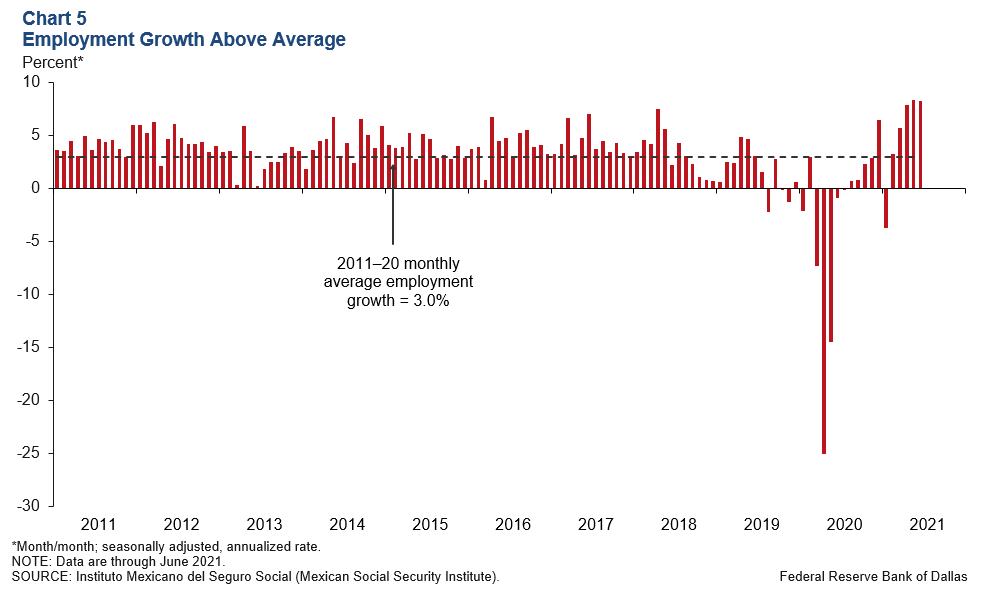
Peso Holds Steady Against the Dollar
The Mexican currency averaged 20.0 pesos per dollar in June, and the exchange rate has remained steady for three months in a row. However, it is still 5.9 percent down from the pre-pandemic level of February 2020 (Chart 6). The Mexican peso has been under pressure due to increased uncertainty regarding the impact of COVID-19 on domestic and global growth.
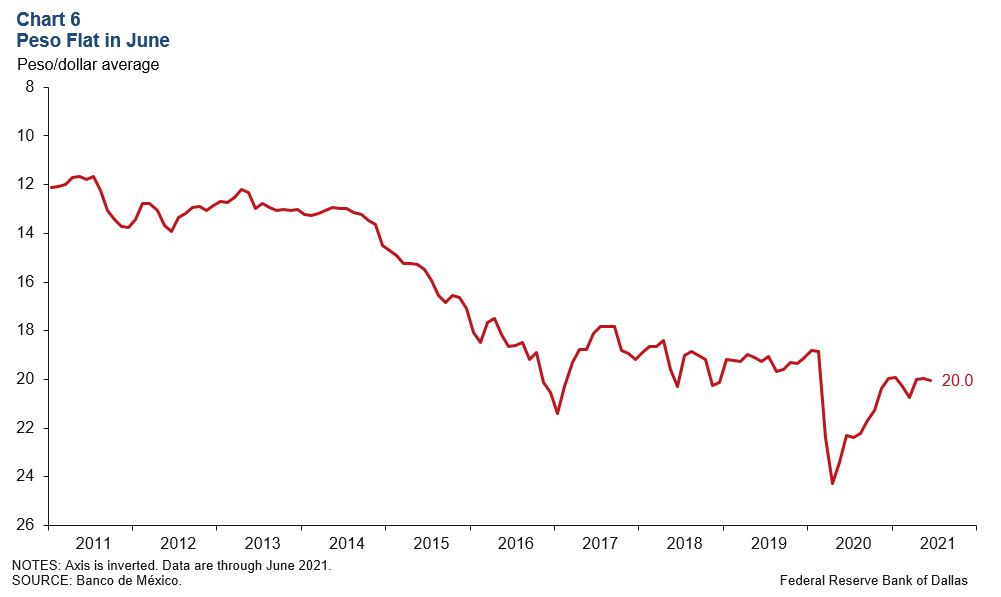
Foreign-Owned Government Debt Share Continues to Fall
The share of foreign‐owned Mexican government securities remained unchanged at 19.8 percent in June, the lowest share since November 2010. The three-month moving average decreased to 19.9 percent (Chart 7). The extent of nonresident holdings of government debt is an indicator of Mexico’s exposure to international investors and also a sign of confidence in the Mexican economy.
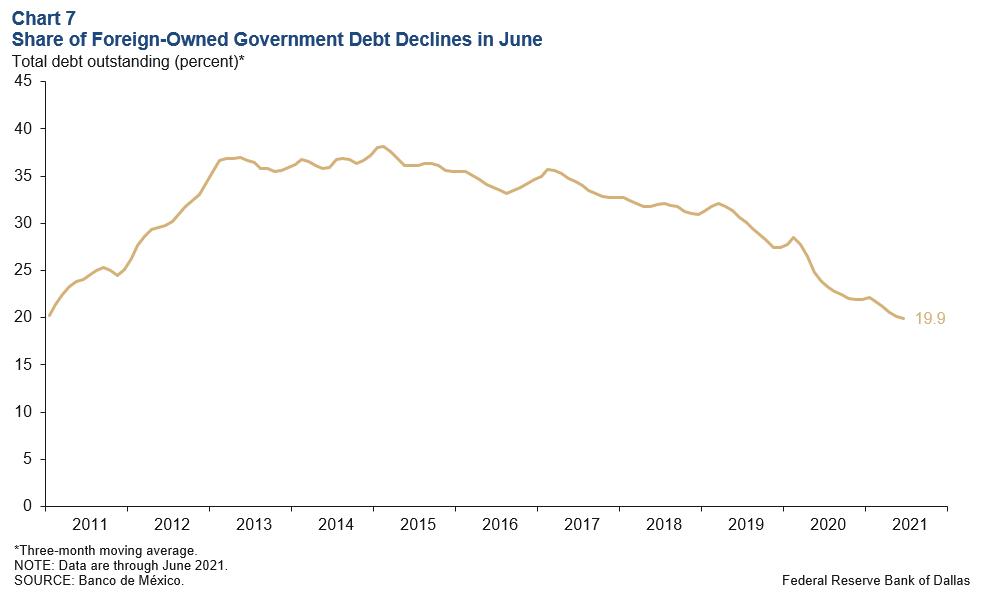
Inflation Flat in June
Mexico’s consumer price index (CPI) increased 5.9 percent in June over the prior 12 months, the same elevated pace as in May (Chart 8). CPI core inflation (excluding food and energy) rose 4.6 percent in June over the previous 12 months. Banco de México increased the benchmark interest rate by 25 basis points to 4.25 percent on June 24. In the public announcement accompanying the interest rate decision, the central bank cited inflation risks, including those created by constrained supply chains and the depreciated value of the peso.
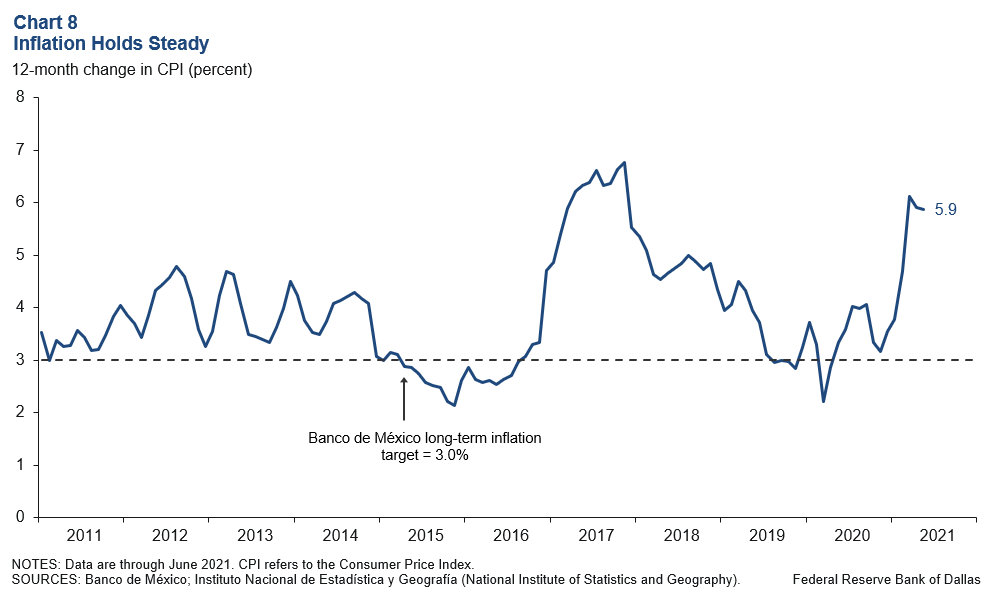
Notes
- GDP growth forecast is based on the average year-over-year quarterly growth that improved from 5.2 percent to 5.8 percent. Encuesta sobre las Expectativas de los Especialistas en Econom'a del Sector Privado: Junio de 2021, (communiqué on economic expectations, Banco de México, June 2021). The survey period was June 24 - 29.
About the Authors
Cañas is a senior business economist, and Coia is a research analyst in the Research Department at the Federal Reserve Bank of Dallas.
Disclaimer: No content is to be construed as investment advice and all content is provided for informational purposes only. The reader is solely responsible for determining whether any investment, ...
more


